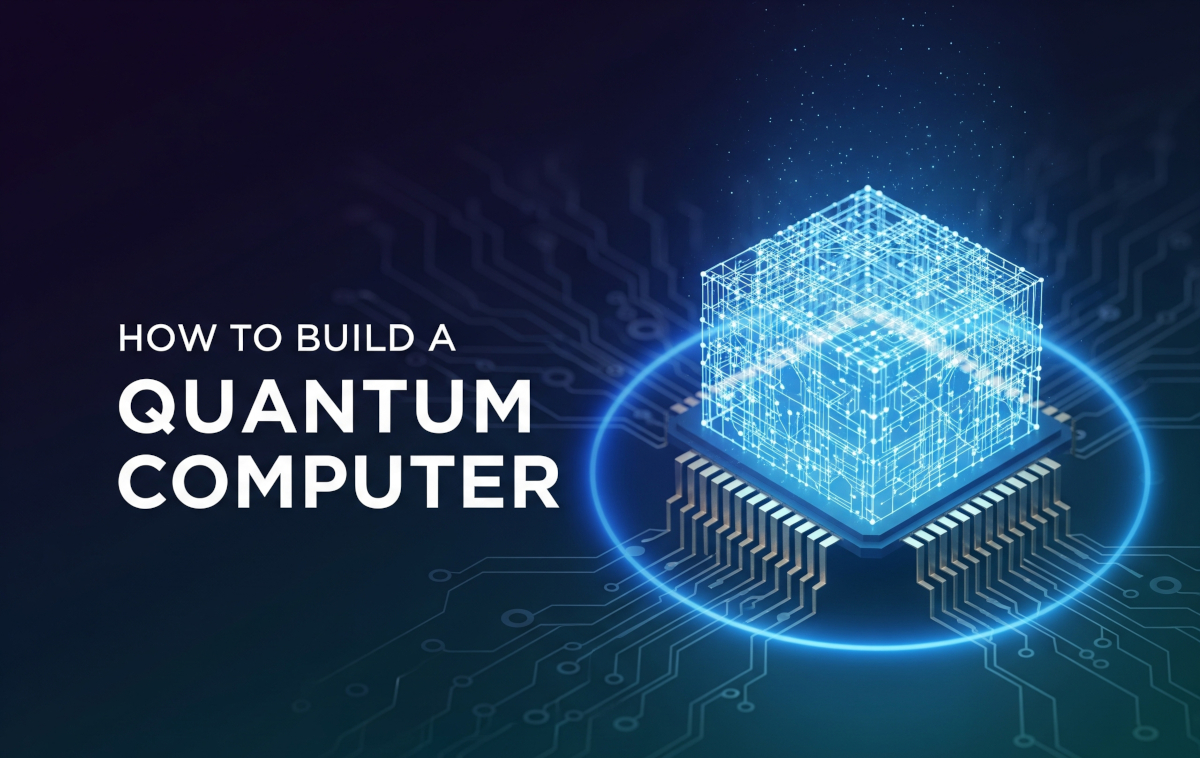How to Build a Quantum Computer: Step by Step Guide
Quantum computing is one of the most exciting and groundbreaking areas of technology.
Researchers across the world, including teams from Oxford University and Virginia Tech, are pushing the boundaries to create quantum computers that can solve problems far beyond the capabilities of today’s classical computers.

These quantum machines, leveraging the peculiar behavior of subatomic particles, have the potential to revolutionize industries like healthcare, finance, and materials science.
But building a quantum computer that’s truly useful is a monumental challenge. It involves expertise in quantum physics, engineering, cryogenics, materials science, and software development. Specialized equipment and highly controlled environments are essential to maintain the delicate quantum states required for computation.
The Current State of Quantum Computing
Quantum computers are not yet at the stage where they outperform classical computers on important problems. According to Virginia Tech professor Ed Barnes, while today’s quantum processors can handle various tasks, they haven’t yet demonstrated their full potential in real-world applications like drug design or energy harvesting. Researchers are working on improving the algorithms that run on quantum machines, with the goal of making them more efficient and versatile.
In a recent interview, Dr. Christopher Ballance from Oxford University stated that quantum computing could “make everything happen better,” from weather forecasting to developing new medicines.
However, before these applications can be realized, quantum computers need to become more reliable and scalable. One of the main obstacles is quantum decoherence—the loss of quantum information due to environmental interference. Overcoming this requires building highly stable qubits and implementing effective quantum error correction protocols.
Here are 7 Steps to Build a Practical Quantum Computer
1. Understand Quantum Basics
To build a quantum computer that’s actually useful, the first step is understanding the basic principles of quantum mechanics. Classical computers process information using bits, which are either a 0 or a 1. Quantum computers use qubits, which can be both 0 and 1 at the same time due to a phenomenon called superposition.
Another key principle in quantum mechanics is entanglement, where quantum particles become interconnected and can affect each other instantly, no matter how far apart they are. This allows quantum computers to process vast amounts of information simultaneously, offering unprecedented computing power.
2. Choose Your Quantum Platform
Not all quantum computers are built the same way. There are several different types of quantum computers, each using different technologies to control qubits. The most common platforms include:
- Superconducting circuits: These are made from materials that conduct electricity without resistance at very low temperatures. Companies like IBM and Google are leading the development of quantum computers based on this technology.
- Trapped ions: This method uses ions (charged atoms) that are trapped and manipulated using lasers. IonQ and Honeywell are among the companies developing trapped-ion quantum computers.
- Quantum dots: Tiny semiconductor particles called quantum dots are used to build qubits. This approach is still in the early stages of development but holds promise for scalability.
- Photonic qubits: These rely on the quantum states of photons (particles of light) and are ideal for transmitting quantum information over long distances.
Each platform has its advantages and limitations, and the choice depends on the specific applications being targeted. For example, superconducting circuits offer speed and integration with existing semiconductor tech, while trapped ions provide better stability. Meanwhile, photonic qubits are promising for quantum networking.
3. Design a Quantum Algorithm
A quantum computer’s usefulness depends on the efficiency of the algorithms it runs. Unlike classical algorithms, which are designed for binary bits, quantum algorithms take advantage of superposition and entanglement to perform complex calculations much faster.
One of the most famous quantum algorithms is Shor’s algorithm, which can factor large numbers exponentially faster than classical algorithms, making it a potential threat to current encryption systems. Another important algorithm is Grover’s algorithm, which can search unsorted databases more efficiently than any classical algorithm.
Virginia Tech researchers are working on developing new quantum algorithms that are tailored to specific quantum hardware. This adaptive approach allows for optimized performance, depending on the type of quantum machine being used.
Developers also rely on specialized quantum programming languages and software tools to build these algorithms. Languages like Qiskit, Cirq, and Q# allow coders to control qubits, build circuits, and simulate behavior before deploying to real quantum hardware.
4. Build a Quantum Circuit
Building the actual quantum circuit is the next major step. A quantum circuit is made up of quantum gates, which manipulate qubits in specific ways. These gates perform operations like flipping a qubit’s state or entangling qubits.
The challenge here is precision. Quantum gates must be extremely accurate, as even the smallest error can cause the system to break down. This requires advanced engineering techniques and ultra-precise control over the quantum particles.
Professor Natalia Ares from Oxford University explains that controlling a quantum circuit with many gates and configurations is one of the toughest engineering problems facing researchers today. Developing these circuits is key to making quantum computers more powerful and reliable.
5. Error Correction and Stability
Quantum systems are highly susceptible to errors because qubits are incredibly fragile. Even small environmental disturbances, like heat or electromagnetic radiation, can cause a qubit to lose its state. This is known as quantum decoherence, and it’s one of the biggest challenges in building a useful quantum computer.
To address this, researchers are developing quantum error correction techniques. These methods involve using additional qubits to detect and correct errors, ensuring the system’s overall stability. However, implementing error correction is complex and requires significant computational overhead.
Systems also need continuous calibration and benchmarking to track performance. Small hardware changes can affect accuracy, so regular tuning is essential to maintain fidelity during operations.
6. Scaling the Quantum Computer
For a quantum computer to be truly useful, it needs to be scalable. Current quantum computers have a limited number of qubits—often less than 100—and while they can demonstrate the principles of quantum computing, they can’t yet solve large-scale problems.
Scaling a quantum computer involves increasing the number of qubits while maintaining their stability and accuracy. This is a major focus of current research, as increasing the qubit count exponentially increases the system’s computing power.
Quantum researchers at Virginia Tech are working on adaptive algorithms to handle different types of quantum hardware and scale them for real-world applications, including chemistry, machine learning, and materials science. Meanwhile, hardware engineers are improving cryogenic systems, such as dilution refrigerators, which are essential for cooling quantum processors to near absolute zero.
7. Test Real-World Applications
Once the hardware and algorithms are optimized, the final step is to test the quantum computer on real-world problems. Researchers are particularly focused on using quantum computers for tasks in chemistry, where they could simulate molecular interactions and design new drugs much more efficiently than classical computers.
Machine learning is another promising application, as quantum computers could process and analyze vast datasets more quickly, improving AI models and decision-making processes.
Other potential areas include logistics optimization, weather forecasting, cryptography, and material design. However, current systems are mostly in the experimental stage, with researchers benchmarking their performance through smaller-scale simulations and prototype runs.
Conclusion: The Future of Quantum Computing
Quantum computing is still in its early days, but researchers are making significant strides toward building machines that are not only powerful but also practical.
From improving algorithms to designing better quantum circuits, the development of quantum computers is steadily progressing. While challenges like error correction, cryogenic cooling, and scalability remain, it is clear that the potential of quantum computing is immense.
For those looking to get involved in building quantum computers, understanding quantum mechanics, choosing the right platform, and focusing on both software and hardware development are essential steps. With continued research, collaboration, and investment, quantum computers will soon transition from experimental tools to real-world problem solvers.
# Written by Elliyas Ahmed







One thought on “How to Build a Quantum Computer: Step by Step Guide”